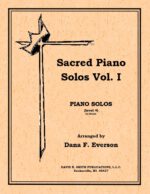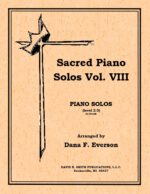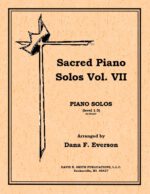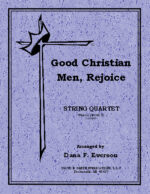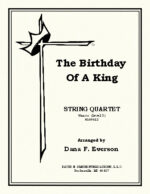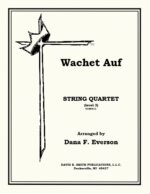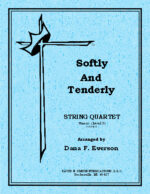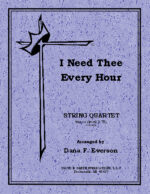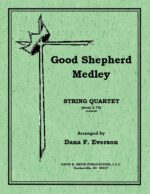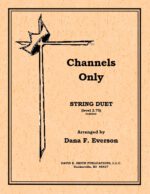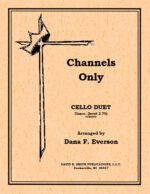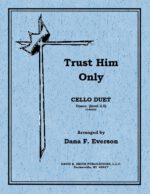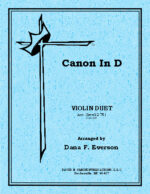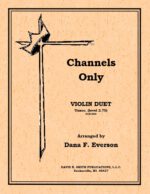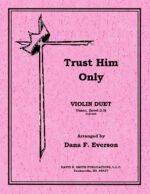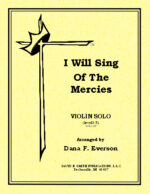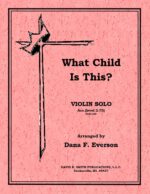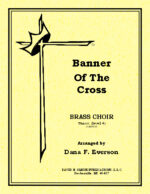-
Take My Life, And Let It Be
$9.00This quartet starts out with imitative voicing and then yieilds to a cello solo line. After a brief transition to a new key the lower voices give way to melodic material only to be answered by the violins in duet form. The third section features the first violin with light accompaniment in the lower voices and then explodes to a sense of finality. Then, rests in a sense of submission.
-
Good Christian Men, Rejoice
$9.00Traditional string quartet with opt. violin part for viola. The piece is rendered as a march with the tune clearly stated in the first violin and then becomes more chordal in the upper three parts. A transition is now presented in an imitation of parts with dynamic changes for interest and further then the cello takes over with the tune while the upper parts give harmonic support. The piece progresses to be more block in harmonic and rhythmical structure only to be turned over to imitation in the melodic material. The coda section is much like the introduction material and builds in dynamic force, only to be concluded with a pizzicato final note.
-
The Birthday Of A King
$9.00For string quartet with optional third violin the piece opens with mutiple entrances and alternates between those devices with more solidly scored, traditional material. Simpe. Rich. Meaningful.
-
-
Softly And Tenderly
$9.00For string quartet with optional third violin the piece opens with a sublime feeling only to be agitated by more vigorous devices.It modulates through various keys and as one would expect it ends softly and gently.
-
-
Good Shepherd Medley
$9.00Traditional string quartet with opt. violin part for viola. The introduction begins in a somewhat solemn nature, building in tension and then in repose where it introduces the hymn “Savior Like A Shepherd Lead Us.” The texture is in a traditional harmonization with the tune in the first violin where it gives over to the cello on the chorus with gentle punctuations in the upper voices. An imitative motif serves as a transition progresses leading into “He Leadeth Me” with the tune in the cello. The violin takes over with a modified tune and then in a fughetta-like series of entrances leads into a modulation where the cello expresses the tune with the upper voices accompanying with moving rhythms. The tune of “All The Way My Savior Leads Me” is presented by the viola with a violin obbligato overhead leading into a full ensemble with rich and moving harmonies. A change of meters gives way to a change of counterpoint and “God Leads Us Along.” Here, it moves amongst the various parts and gives way to sweet release.
-
Channels Only
$5.00A Violin-cello duet beginning with a motivic introduction followed by part one presenting a modified melody with part two using a moving countermelody. The next phrase the roles are reversed. Next a modulation occurs and the melodic material is much like the first verse followed my another modulation. The coda section is much like the introduction only this time in a different meter and concludes in a simplistic fashion.
-
Trust Him Only
$5.50Scored for two unaccompanied strings it begins with a motif in imitation… The first thematic statement is made with a delicately altered theme in the upper line while the lower line moves in a gentle counterpoint.. The second section is in a new key at a higher level with the melody alters even more while the second voice is more expressive and stretched out. The next section changes key once again and mirrors the movement of the first section. Again, a modulation takes place and the parts are more bold and duet like in their presentation. A final modulation takes the piece upward and the style is more bold where it comes to a brief Coda- where it relaxes into a quite confidence.
-
It Came Upon A Midnight Clear
$6.50Score for two strings and piano this easier piece shows a delicate counterpoint between the instruments along with some sensitive motivic embellsihments.
-
Channels Only
$5.00A Cello duet beginning with a motivic introduction followed by part one presenting a modified melody with part two using a moving countermelody. The next phrase the roles are reversed. Next a modulation occurs and the melodic material is much like the first verse followed my another modulation. The coda section is much like the introduction only this time in a different meter and concludes in a simplistic fashion.
-
Trust Him Only
$5.50Scored for two unaccompanied strings it begins with a motif in imitation… The first thematic statement is made with a delicately altered theme in the upper line while the lower line moves in a gentle counterpoint.. The second section is in a new key at a higher level with the melody alters even more while the second voice is more expressive and stretched out. The next section changes key once again and mirrors the movement of the first section. Again, a modulation takes place and the parts are more bold and duet like in their presentation. A final modulation takes the piece upward and the style is more bold where it comes to a brief Coda- where it relaxes into a quite confidence.
-
Channels Only
$5.00A Viola duet beginning with a motivic introduction followed by part one presenting a modified melody with part two using a moving countermelody. The next phrase the roles are reversed. Next a modulation occurs and the melodic material is much like the first verse followed my another modulation. The coda section is much like the introduction only this time in a different meter and concludes in a simplistic fashion.
-
Canon In D
$6.00Written for 2 violins and piano, this arrangement extracts a portion of the original work and will serve well for various ceremonies.
-
Channels Only
$5.00A Violin duet beginning with a motivic introduction followed by part one presenting a modified melody with part two using a moving countermelody. The next phrase the roles are reversed. Next a modulation occurs and the melodic material is much like the first verse followed my another modulation. The coda section is much like the introduction only this time in a different meter and concludes in a simplistic fashion.
-
Trust Him Only
$4.50Scored for two unaccompanied strings it begins with a motif in imitation… The first thematic statement is made with a delicately altered theme in the upper line while the lower line moves in a gentle counterpoint.. The second section is in a new key at a higher level with the melody alters even more while the second voice is more expressive and stretched out. The next section changes key once again and mirrors the movement of the first section. Again, a modulation takes place and the parts are more bold and duet like in their presentation. A final modulation takes the piece upward and the style is more bold where it comes to a brief Coda- where it relaxes into a quite confidence.
-
It Came Upon A Midnight Clear
$5.50Score for two strings and piano this easier piece shows a delicate counterpoint between the instruments along with some sensitive motivic embellsihments.
-
I Will Sing Of The Mercies
$5.50Enthusiasm is the nature of this solo. It goes through many transformations of the melody but continually remains joyous. This piece would serve very well as special music in a service.
-
What Child Is This
$4.50A violin solo with piano accompaniment. The pieces starts out with piano only and allows the entrance of the solo violin and a rather straight forward rendition of this beloved song. After a brief transition the solo is modified with a constant modified and moving line while being supported by a single voice counterpoint in the left hand of the piano. The chorus is then a bit more staid and the accompaniment more chordal. Another brief piano interlude is stated with melodic material and the piece becomes more fragmented and motivic with a gentle settling to the end.
-
-
Banner Of The Cross
$16.00For brass choir, including 3 trumpets, horn, 2 trombones, baritone, and tuba, the piece starts out in a reflective mood gaining energy to a more fanfare-like presentation of the melody. The second section is more Celtic in nature, ends gloriously.
-
Faith Is The Victory
$12.00A Brass choir written for four trumpets, (Opt Horn), two trombones, baritone and tuba. A solid introduction with motives passed around the various parts. The chorus is now given with the theme in the upper lines. Then echoed back in the lowest voice. A brief meter shift and then the harmonized theme gives a sense of security. Then another meter shift with line that acts as a Q&A in a smooth and expressive manner. Now the piece, through a DS gravitates back until it reaches a CODA and ends on a high note- in block structure.

